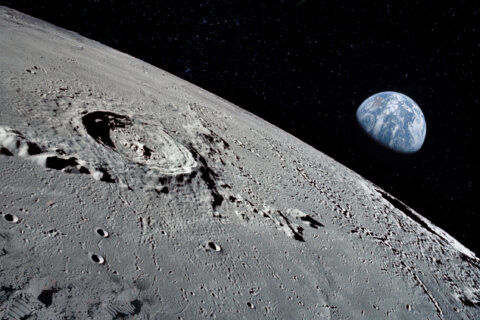WASHINGTON – Darren Aronofsky is the most shockingly provocative filmmaker we have going today, melding a Bergman-style existentialism with a Hitchcockian dark side, Kubrick-level ambitions and a Howard Hawks versatility of genre.
In just five films, he’s delivered a sci-fi thriller (“Pi”), an anti-drug drama (“Requiem for a Dream”), an eternal romance (“The Fountain”), a gritty sports flick (“The Wrestler”) and a horror ballet that, for my money, should have won him Best Director (“Black Swan”).
Now, in his sixth feature, the mad genius attempts arguably his toughest genre yet: the Biblical epic.
We all know the story of Noah’s Ark: The Creator is fed up with mankind’s wickedness and decides to send a great flood to wash the world clean and start over. He commands Noah to build a giant ship to preserve two of each animal species that will then repopulate the world after the waters subside. The story inspired Aronofsky to write a poem that won an award from the United Nations when he was just 13 years old. Ever since, it’s been his lifelong ambition to make the film and a 10-year struggle in Hollywood to get it made. Such blinding pet projects can be treacherous waters for filmmakers.
Here’s my video review of “Noah”
“Noah” has all the makings of a potential 4-star masterpiece: an epic tale from an ambitious filmmaker building a finely-crafted cinematic vessel, except for a single, glaring Achilles heel that rips a large hole in its hull, taking on so much water that it threatens to sink the entire ship.
I’m talking about a controversial group of characters known as The Watchers, a collection of CGI rock creatures that look like the talking-tree Ents from “The Lord of the Rings” and move like the bots from “Transformers.” Yes, they are loosely based in the Nephilim (Hebrew for “giants”), which are briefly mentioned in Genesis. And yes, their journey from fallen angels to redemptive servants is an admirable arc (no pun intended). But as the clunky creatures help Noah build the ark, then fend off an army invasion from the descendents of Cain, most viewers will be taken out of the movie.
That’s a shame, because what a movie it is. How do you look your filmmaking idol in the face, the man you believe is the most exciting filmmaker today, and humbly say, “What were you thinking?”
Aronofsky himself knew this would be a problem during the editing phase, repeatedly going to Industrial Light and Magic (ILM) because he was unhappy with The Watchers. By this point, however, they were baked into the cake. This is the danger of CGI, folks, a lesson Aronofsky should have learned when Portman’s CGI legs snapped backward — the sole directing misstep in “Black Swan.”
In the case of “Noah,” there was plenty of room for measured CGI, from the animals to the ark to the floods. All of these are done brilliantly, particularly the shooting geysers that burst through the earth to join the rain from above. But while the massive CGI battles between humans and geological creatures were effective in Peter Jackson’s “The Two Towers,” they feel out of place here.
This is not to say Aronofsky should have held steadfast to a strict, literal recount of the Genesis story. On the contrary, it’s refreshing to see him deviate with such artistic license and moral complexity.
In doing so, he offers creative answers to questions that have puzzled many of us since Sunday school: Why didn’t Adam prevent Eve from biting the forbidden fruit? Easy — he was distracted by a snakeskin shed by the very serpent that tempted his wife. How on earth did Noah round up all those animals? Easy — they came to him. How did all those animals not devour each other in a cramped space for 40 days and 40 nights? Easy — they all went into a divine hibernation.
Bible literalists may despise such deviations. This is no doubt the reason for Paramount’s timid release strategy, shutting out critics in many cities until the very last minute, and why the studio has been running this disclaimer during various promotions: “The film is inspired by the story of Noah. While artistic license has been taken, we believe that this film is true to the essence, values and integrity of a story that is a cornerstone of faith for millions of people worldwide. The biblical story of Noah can be found in the Book of Genesis.”
Make no mistake — this isn’t your shiny Biblical epic like “The Ten Commandments” (1956), “Ben-Hur” (1959) or “The Bible” (1966), which John Huston directed, narrated and starred in as Noah. Even then, the darkness wasn’t far away. Eight years later, Huston played a different Noah, the corrupt, incestuous Noah Cross in “Chinatown” (1974), Roman Polanski’s first hit since “Rosemary’s Baby” (1968) due to his pregnant wife’s murder by the Manson Family in the “helter skelter” of 1969.
Aronofsky’s “Noah” is the type of world Noah Cross would like. It isn’t a lush paradise, nor should it be. It’s a bleak, desolate world with muted colors and an apocalyptic atmosphere. Even the ark is box-shaped, rather than the glorious cubit curves of classic storybook pages. Just as “The Dark Knight” lost the candy-colored gadgets of Adam West’s Batman, “Noah” strips away the fancy to suggest “it’s always darkest before the dawn.” All this is necessary to portray a time when wickedness was supposedly so strong that it needed to be destroyed.
This entire premise is framed by a centuries old struggle between good and evil, where Noah (Russell Crowe) represents the descendants of Adam’s virtuous son Seth, while Tubal-cain (Ray Winstone) represents the descendants of Adam’s wicked son Cain, who killed Abel in the Bible’s first murder.
Noah and Tubal-cain may be hero and villain, respectively, but Aronofsky realizes they’re two sides of the same coin. Tubal-cain believes in God, but feels God has long since forsaken humanity. He says, “I’m not afraid of miracles” and shouts toward the heavens, “Why won’t you speak to me?” It’s Lieutenant Dan shouting in the storm, daring God to drown him, only this time it’s Biblical.
Noah is no less tormented. Rather than a saintly, pure, righteous protagonist, he is instead haunted by visions of the flood and confused at his Creator’s divine directives, doubting whether or not he has really carried out God’s will. Even after surviving the storm, he finds himself face first in the sand, naked and drunk. As he tells his sons, “The wickedness is not just in them. It’s in all of us.”
In this way, Aronofsky goes the route of Scorsese’s “The Last Temptation of Christ” (1988) rather than the recent gloss of “Son of God” (2014). And like John Wayne’s Ethan Edwards at the end of “The Searchers” (1956), Noah must face his own Abraham-Isaac sacrificial choice.
All this is fertile ground for Crowe, who’s had some stinker roles over the past several years, from “Robin Hood” (2010) to “Les Miserables” (2012). “Noah” reminds us of Crowe at his best, whether it’s detectives in the streets of “L.A. Confidential” (1997) and “American Gangster” (2007), or warriors in the arenas of “Cinderella Man” (2005) and “Gladiator” (2000). As Noah visits the 900-year-old Methuselah (Anthony Hopkins), you’ll recall Crowe’s Jor-El in “Man of Steel” (2013). When Noah dramatically turns to Tubal-cain to say, “I am Noah, son of Lamech,” it’s spoken so much like Maximus that we expect him to follow with, “I will have my vengeance, in this life or the next.”
But the best performance does not come from the title character. That honor belongs to Jennifer Connelly as Noah’s wife, Naameh, delivering the film’s biggest heaving-chest moments. The Crowe-Connelly pairing is not only an effective reunion from “A Beautiful Mind” (2001); it’s a love story not unlike Jack and Rose aboard the “Titanic” (1997) — two hearts jostled by the waves. In the face of Crowe’s internal conflict, it is Connelly who must serve as the film’s moral conscience and the glue of the family that includes their sons Ham (Logan Lerman), Shem (Douglas Booth) and Japeth (Leo McHugh Carroll), and their future daughters-in-law (Emma Watson, Madison Davenport).
Aronofsky’s ability to get strong performances from his cast should be no surprise. He coached two of the best performances of the past six years: Natalie Portman’s dual ballerina Nina Sayers (which won the Oscar) and Mickey Rourke’s wrestler Randy “The Ram” Robinson (which should have won the Oscar). What’s more, he put Connelly on the map in “Requiem,” alongside a young Jared Leto, Marlon Wayans and Ellen Burstyn, who found her best role since “Alice Doesn’t Live Here Anymore” (1974).
But Aronofsky’s ability to find good performances is just half of his directorial power. He also has an unrivaled visual mind for the cinematic language:
- Aronofsky sets his tone early with an almost storybook opening of “In the beginning,” where a cartoonish snake, apple and Cain murder rock become a three-beat montage that recurs throughout the film.
- He offers creative use of time-lapse photography, the best attempt since Terrence Malick’s “The Tree of Life” (2011) at showing the formation of the earth and the evolution of all its organisms.
- Noah’s visions of flooding are justifiably horrific. They are not depicted as a booming voiceover from God, but rather a visceral nightmare of mankind and animals drowning underwater.
- The first rain drop of the impending flood is brilliant, appearing as if the camera is attached to the rain drop, starting from a bird’s-eye view that plummets toward earth and lands on Noah’s cheek, like a teardrop.
- Rather than his camera following closely behind heads (i.e. “The Wrestler,” “Black Swan”) or attached to torsos that characters can’t escape (i.e. “Requiem for a Dream”), Aronofsky constantly cranes away from his characters in “Noah,” reminding us of the Creator above.
- Finally, his use of sound is extremely effective, going nearly silent with aquatic echoes as we plunge underwater, then erupting again as we reemerge. Once again, Aronofsky gets a powerhouse score from Clint Mansell, whose harrowing scores for “Requiem for a Dream” and “Black Swan” are truly iPod- worthy.
Beyond any of this, Aronofsky masters his pacing, keeping our attention for nearly 2 1/2 hours, despite Paramount’s desire to chop it down. Our focus rests in knowing that for each moment of despair, there’s another glimmer of hope. The earth’s demise is not depicted so much as destruction, but as rebirth. As Noah says, “Fire consumes. Water cleanses.”
Let’s hope the film has a similar cleansing effect on Aronofsky’s career. A “Waterworld” flop it is not, but one has to wonder whether the $130 million spectacle finally compromised Aronofsky’s better angels. Or, perhaps there’s a “holy trinity” at work, where Aronofsky makes two stellar films, then pushes too hard on the third. Just as he followed “Pi” and “Requiem” with the head-scratching “Fountain,” he now follows “The Wrestler” and “Black Swan” with more puzzling choices in “Noah.” His movies are much better “two by two” than “three by three.”
Okay, Mr. Aronfosky, you’ve gotten your pet project out of the way. Now let’s get back to the intimate stories you’re so good at telling. Your talents are far better served in the tight spaces of addicts, masochists and starving artists than millennium-spanning transcendence. In the meantime, thanks for the same lesson that Noah himself learns: all humans are flawed, even great filmmakers.
★ ★ ★
The above rating is based on a 4-star scale. See where this film ranks in Jason’s 2013 Movie Guide. Follow WTOP Film Critic Jason Fraley on Twitter @JFrayWTOP, read his blog The Film Spectrum or listen Friday mornings on 103.5 FM.








